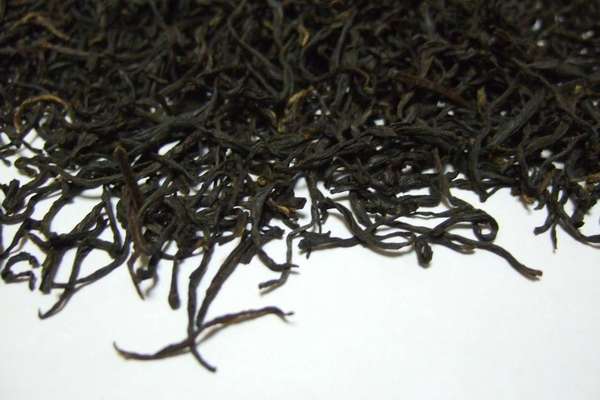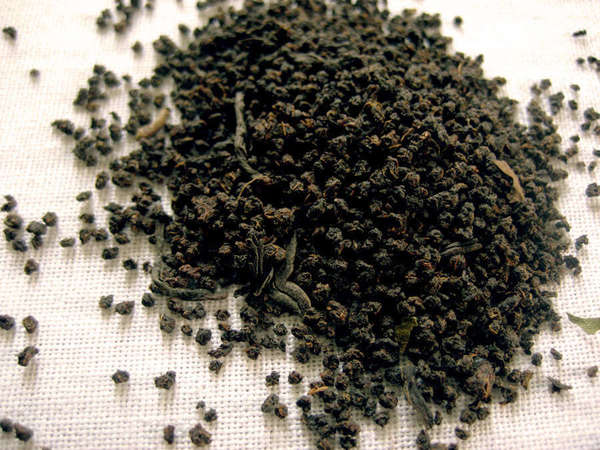Grades of Tea
Wikipedia: Orange_pekoe#Manufacture_and_gradesLast Updated: Aug. 21, 2024
 Loose-Leaf Assam FTGFOP1 Black Tea, Tonganagaon Estate, © Akuppa John Wigham, CC BY 2.0.
Loose-Leaf Assam FTGFOP1 Black Tea, Tonganagaon Estate, © Akuppa John Wigham, CC BY 2.0.What teas and companies use this system?
This grading system is typically only used for black tea, and even then, not for all black teas. It is more common in loose-leaf tea sold by specialized tea retailers with a focus on British and other Western tea cultures. Green tea, oolongs, white tea, and black teas produced in China and Taiwan tend not to use this system. Marketers of teabags rarely advertise the grade of their tea, except for the common grade of orange pekoe.What does grade mean?
Most of the information of this grading system of tea pertains only to leaf size. Although whole-leaf teas are often presented as higher quality, more desirable, and are often more expensive, it is impossible to generalize. Some broken-leaf teas can be outstanding, just as whole-leaf teas can be mediocre.The grade reflects the caffeine content of a tea to a large degree. Because leaf buds contain more caffeine than mature leaves, tippy teas like TGFBOP contain more caffeine than OP or FOP grades; similarly, Souchong grades, made out of larger, older leaves contain even less caffeine. Grade also affects brewing. Whole-leaf teas tend to need longer infusion times, whereas broken leaf teas require shorter steeping, and fannings and dust infuse the fastest. Whole-leaf teas are also best for multiple infusions, although most of the teas that are used for multiple infusions are not graded according to the system on this page.
The letter abbreviations can also be confusing, as the letter F can mean "Flowery", "Fine", or "Fannings".
 This Keemun Black Tea is FTGFOP grade, a high grade of tea, which is reflected in the fully-intact leaves. © Whiteness (Wikimedia Commons), CC BY-SA 4.0.
This Keemun Black Tea is FTGFOP grade, a high grade of tea, which is reflected in the fully-intact leaves. © Whiteness (Wikimedia Commons), CC BY-SA 4.0.Misconceptions and myths: what doesn't tea grade mean?
A common myth about tea grade is that higher-grade tea is always better tea, and another widespread misconception is that tea of higher grades is always higher-priced. Many factors influence tea's quality and characteristics, and furthermore, enjoyment of a particular batch of tea is subjective, as different people have different tastes. Tea of any grade can be lower in quality if it's not fresh, especially if it has been stored improperly. And higher grades are often mild-flavored, lighter-bodied, and higher in caffeine, something not all people desire.Sometimes you can find particular high-grade batches of tea for bargain prices. Other teas of lower grade may sell for a premium because they originate from a well-known garden or estate, or because something else about the batch has made them particularly desirable.
Grades of Orthodox Tea
Whole leaf tea
Whole leaf tea refers to tea that has not been broken or torn during production. The size and shape of the leaf varies widely, both as a function both of the types of leaves used, and how it is processed.- SFTGFOP1 - Special Finest Tippy Golden Flowery Orange Pekoe, Grade 1 - Usually the highest grade of tea for sale. Typically only Darjeelings, or occasionally teas from Assam, Nepal, or other nearby regions.
- SFTGFOP - Special Finest Tippy Golden Flowery Orange Pekoe - Like SFTGFOP1, mostly Darjeelings and occasionally teas from surrounding regions.
- STGFOP(1) - Silver Tippy Golden Flowery Orange Pekoe (Grade 1) - An uncommonly available top grade of tea, this is also among the highest grades of tea for sale, and tends to have a higher portion of silvery tips. This grade is seen both in Darjeeling and Assam.
- FTGFOP1 - Fine/Finest Tippy Golden Flowery Orange Pekoe Grade 1
- FTGFOP - Fine/Finest Tippy Golden Flowery Orange Pekoe
- TGFOP1 - Tippy Golden Flowery Orange Pekoe Grade One
- TGFOP - Tippy Golden Flowery Orange Pekoe - This and higher grades are usually only produced in Assam, Darjeeling, and surrounding Himalayan regions, uncommonly in Yunnan province. This grade is common in Assam and Darjeeling teas.
- GFOP - Golden Flowery Orange Pekoe - Distinguished from FOP by a larger proportion of tip. This grade is common among African teas, especially Kenyan teas.
- FOP - Flowery Orange Pekoe
- OP - Orange Pekoe - This is the "standard" or most common grade of black tea. However, most companies selling "orange pekoe" tea in teabags are actually selling more broken grades.
- OPA - Orange Pekoe A, A long-leaf tea with large, thick leaves, that can be either tightly-wound or more open. Most common in Ceylon black tea, and commonly consumed in Russian and Middle Eastern tea cultures.
- FP - Flowery Pekoe
- P - Pekoe
- S - Souchong
Broken-leaf tea
Broken-leaf tea is tea that has been torn or broken, but is still in large enough pieces to be recognizable as pieces of leaf.- BOP1 - Broken Orange Pekoe One
- GFBOP - Golden Flowery Broken Orange Pekoe
- TGFBOP - Tippy Golden Flowery Broken Orange Pekoe
- TGFBOP1 - Tippy Golden Flowery Broken Orange Pekoe Grade One
- BS - Broken Souchong
- BPS - Broken Pekoe Souchong
- GBOP - Golden Broken Orange Pekoe
FBOP - Flowery Broken Orange Pekoe - BOP - Broken Orange Pekoe - A standard grade of broken-leaf tea, often offering good value.
Fannings
Fannings are finely-broken pieces of tea leaf that still have a recognizable coarse texture; they are the grade of tea used in most tea bags.- FBOPF (Ex. Spl.) or FBOPFEXS - Flowery Broken Orange Pekoe Fannings Extra Special - The highest grade of fannings typically sold, and often looking visually close to broken-leaf teas, with some larger, more intact pieces of leaf. To our knowledge, only occurring in Ceylon teas.
- FBOPF - Flowery Broken Orange Pekoe Fannings - Relatively common in Ceylon teas, and uncommon among Indian and Chinese teas.
- TBOPF - Tippy Broken Orange Pekoe Fannings - A rarely used grade of tea, used in Kerala. A high grade of fannings, higher in tips, but more broken than FBOPF.
- BOPF - Broken Orange Pekoe Fannings
- FOF - Flowery Orange Fannings - Relatively finely broken, but with a large portion of tip. Rarely sold, but typically good quality.
- GOF - Golden Orange Fannings - A lower grade of fannings typically used in blending and flavoring, rarely marketed as such. Occurs in Assam and occasionally sold openly.
Dust
Dust is a fine powder, much finer than fannings, made of tea particles left over from producing higher grades of tea. Tea made by pulverizing larger pieces of leaf or the tea plant, such as Matcha, is not classified as dust.- OPD - Orange Pekoe Dust
- BOPD - Broken Orange Pekoe Dust
- BOPFD - Broken Orange Pekoe Fine Dust
- FD - Fine Dust
- D-A - Dust A
- Spl. D - Special Dust
- GD - Golden Dust
- OD - Orthodox Dust
In practice, you will never see loose-leaf tea dust for sale; it is typically sold wholesale and packed into teabags. Because of its low grade, companies using it generally do not advertise that they are doing so, so you will not see dust grades displayed on tea bag packaging or labels.
 Typical CTC Black Tea, © Naresh.limbu (Wikipedia), CC BY-SA 3.0.
Typical CTC Black Tea, © Naresh.limbu (Wikipedia), CC BY-SA 3.0.Grades of CTC Tea
CTC (crush-tear-curl) tea is tea that has been produced by a modern, mechanical process that tears the leaf in order to induce oxidation, rather than manually rolling it to bruise the leaf, as in the production of orthodox tea. Because the CTC process breaks the leaf, there is no whole-leaf CTC tea, and thus CTC tea is divided into broken-leaf, fannings, and dust. CTC is widely regarded as inferior, and the primary benefit is its lower cost of production, due to automation, although like other teas, CTC tea still varies widely in quality.It is less common for tea drinkers to see CTC tea graded in tea for sale in stores or online. CTC tea grades include, for broken leaf tea, BP, BOP, BPS, BP1, and FP, and for fannings, OF, PF, and BOPF. There are a myriad of grades for CTC dust.

